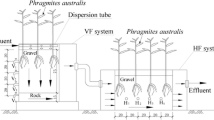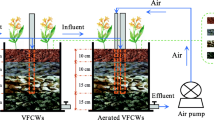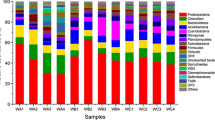Abstract
A pilot-scale horizontal subsurface flow constructed wetland (HFCW) was established to investigate the feasibility of removing nutrients from natural water in Lake Xijiu, Jiangsu Province, China. The HFCW, planted with reeds (Phragmites communis) and irises (Iris tectorum Maxim), was operated for 227 days. The mean removal efficiency of NH4+-N was 36.7%, of total nitrogen (TN) 70.2%, of total phosphorus 75.3%, of permanganate index (CODMn) 35.8%, and of Chlorophyll a 70.0%. The effluent concentrations of these pollutants were all within the Grade III threshold of China’s water quality standards for surface water. Correlation analysis showed that TN removal was related to the CODMn concentration in the influent (r2 = 0.65) and was closely related to the temperature (r2 = 0.91). The HFCW had a water production efficiency of 98%–99% over the entire operational period, which suggests that it did not block easily. Results from 16S rDNA high-throughput sequencing showed that Proteobacteria (40.65%) dominated at the phylum level. At the genus level, the relative abundance of Nitrosomonadaceae (3.57%) was highest in autumn and the spatial distribution from the front to the back varied slightly from 2.57% to 2.99%. Our results will help researchers to develop optimal designs for HFCW systems to treat slightly polluted water.







Similar content being viewed by others
References
Ahn C, Gillevet PM, Sikaroodi M (2007) Molecular characterization of microbial communities in treatment microcosm wetlands as influenced by macrophytes and phosphorus loading. Ecological Indicators 7:852–863
APHA, AWWA, WEF (2005) Standard methods for the examination of water and wastewater. American Public Health Association, Washington, DC
Baptista JDC, Donnelty T, Rayne D, Davenport RJ (2003) Microbial mechanisms of carbon removal in subsurface flow wetlands. Water Sci Technol 48:127–134
Braeckevelt M, Mirschel G, Wiessner A, Rueckert M, Reiche N, Vogt C, Schultz A, Paschke H, Kuschk P, Kaestner M (2008) Treatment of chlorobenzene-contaminated groundwater in a pilot-scale constructed wetland. Ecological Engineering. 33:45–53
Calheiros CS, Rangel AO, Castro PM (2007) Constructed wetland systems vegetated with different plants applied to the treatment of tannery wastewater. Water Research 41:1790–1798
Chen Z, Wu S, Braeckevelt M, Paschke H, Kästner M, Köser H, Kuschk P (2012) Effect of vegetation in pilot-scale horizontal subsurface flow constructed wetlands treating sulphate rich groundwater contaminated with a low and high chlorinated hydrocarbon. Chemosphere. 89:724–731
Cronk JK, Mitsch WJ (1994) Aquatic metabolism in four newly constructed freshwater wetlands with different hydrologic inputs. Ecological Engineering. 3:449–468
Ding Y, Wang W, Liu X, Song X, Wang Y, Ullman JL (2016) Intensified nitrogen removal of constructed wetland by novel integration of high rate algal pond biotechnology. Bioresource Technology. 219:757–761
Gao J, Wang W, Guo X, Zhu S, Chen S, Zhang R (2014) Nutrient removal capability and growth characteristics of Iris sibirica in subsurface vertical flow constructed wetlands in winter. Ecological Engineering. 70:351–361
Gottschall N, Boutin C, Crolla A, Kinsley C, Champagne P (2007) The role of plants in the removal of nutrients at a constructed wetland treating agricultural (dairy) wastewater. Ontario, Canada, Ecological Engineering. 29:154–163
Guan W, Yin M, He T, Xie S (2015) Influence of substrate type on microbial community structure in vertical-flow constructed wetland treating polluted river water. Environmental Science and Pollution Research. 22:16202–16209
Gunten UV, Gallard H (2002) Chlorination of natural organic matter: kinetics of chlorination and of THM formation. Water Research 36:65–74
Harms G, Layton AC, Dionisi HM, Gregory IR, Garrett VM, Hawkins SA, Robinson KG, Sayler GS (2003) Real-time PCR quantification of nitrifying bacteria in a municipal wastewater treatment plant. Environmental Science & Technology. 37:343–351
Hu J, Shang R, Deng H, Heijman SGJ, Rietveld LC (2014) Effect of PAC dosage in a pilot-scale PAC–MBR treating micro-polluted surface water. Bioresource Technology. 154:290–296
Hu Y, He F, Ma L, Zhang Y, Wu Z (2016) Microbial nitrogen removal pathways in integrated vertical-flow constructed wetland systems. Bioresource Technology. 207:339–345
Huang L, Gao X, Guo J, Ma X, Liu M (2011) Study on the purification efficiency of Micro-Polluted River treated by subsurface horizontal flow constructed wetlands. Procedia Environmental Sciences 10:908–913
Huang L, Gao X, Liu M, du G, Guo J, Ntakirutimana T (2012) Correlation among soil microorganisms, soil enzyme activities, and removal rates of pollutants in three constructed wetlands purifying micro-polluted river water. Ecological Engineering. 46:98–106
Ibarbalz FM, Figuerola ELM, Erijman L (2013) Industrial activated sludge exhibit unique bacterial community composition at high taxonomic ranks. Water Research 47:3854–3864
Ibekwe AM, Lyon SR, Leddy M, Jacobson-Meyers M (2007) Impact of plant density and microbial composition on water quality from a free water surface constructed wetland. Journal of Applied Microbiology. 102:921–936
Jinadasa KB, Tanaka N, Sasikala S, Werellagama DR, Mowjood MI, Ng WJ (2008) Impact of harvesting on constructed wetlands performance-a comparison between Scirpus grossus and Typha angustifolia. Journal of Environmental Science and Health Part A. 43:664–671
Jing Z, He R, Hu Y, Niu Q, Cao S, Li YY (2015) Practice of integrated system of biofilter and constructed wetland in highly polluted surface water treatment. Ecological Engineering. 75:462–469
Lee C, Fletcher TD, Sun G (2010) Nitrogen removal in constructed wetland systems. Engineering in Life Sciences. 9:11–22
Lin JL, Tu YT, Chiang PC, Chen SH, Kao CM (2015) Using aerated gravel-packed contact bed and constructed wetland system for polluted river water purification: a case study in Taiwan. Journal of Hydrology 525:400–408
Nguyen LM (2000) Organic matter composition, microbial biomass and microbial activity in gravel-bed constructed wetlands treating farm dairy wastewaters. Ecological Engineering. 16:199–221
Paranychianakis NV, Tsiknia M, Kalogerakis N (2016) Pathways regulating the removal of nitrogen in planted and unplanted subsurface flow constructed wetlands. Water Research 102:321–329
Rai UN, Tripathi RD, Singh NK, Upadhyay AK, Dwivedi S, Shukla MK, Mallick S, Singh SN, Nautiyal CS (2013) Constructed wetland as an ecotechnological tool for pollution treatment for conservation of ganga river. Bioresource Technology. 148:535–541
Søvik AK, Kløve B (2007) Emission of N2O and CH4 from a constructed wetland in southeastern Norway. Science of the Total Environment. 380:28–37
Tang X, Huang S, Scholz M, Li J (2011) Nutrient removal in vertical subsurface flow constructed wetlands treating eutrophic river water. International Journal of Environmental Analytical Chemistry. 91:727–739
Taylor CR, Hook PB, Stein OR, Zabinski CA (2011) Seasonal effects of 19 plant species on COD removal in subsurface treatment wetland microcosms. Ecological Engineering. 37:703–710
Truu M, Juhanson J, Truu J (2009) Microbial biomass, activity and community composition in constructed wetlands. Science of the Total Environment. 407:3958–3971
Villaseñor J, Capilla P, Rodrigo MA, Cañizares P, Fernández FJ (2013) Operation of a horizontal subsurface flow constructed wetland--microbial fuel cell treating wastewater under different organic loading rates. Water Research 47:6731–6738
Vymazal J (2005) Horizontal sub-surface flow and hybrid constructed wetlands systems for wastewater treatment. Ecological Engineering. 25:478–490
Vymazal J (2007) Removal of nutrients in various types of constructed wetlands. Science of the Total Environment. 380:48–65
Wang Q, Xie H, Ngo HH, Guo W, Zhang J, Liu C, Liang S, Hu Z, Yang Z, Zhao C (2016) Microbial abundance and community in subsurface flow constructed wetland microcosms: role of plant presence. Environmental Science and Pollution Research. 23:4036–4045
Wu H, Zhang J, Li P, Zhang J, Xie H, Zhang B (2011) Nutrient removal in constructed microcosm wetlands for treating polluted river water in northern China. Ecological Engineering. 37:560–568
Wu J, Zhang J, Jia WL, Xie HJ, Gu RR, Li C, Gao BY (2009) Impact of COD/N ratio on nitrous oxide emission from microcosm wetlands and their performance in removing nitrogen from wastewater. Bioresour Technol 100:2910–2917
Xu F, Cao FQ, Kong Q, Zhou LL, Yuan Q, Zhu YJ, Wang Q, du YD, Wang ZD (2018) Electricity production and evolution of microbial community in the constructed wetland-microbial fuel cell. Chemical Engineering Journal. 339:479–486
Xu F, Ouyang DL, Rene ER, Ng HY, Guo LL, Zhu YJ, Zhou LL, Yuan Q, Miao MS, Wang Q, Kong Q (2019) Electricity production enhancement in a constructed wetland-microbial fuel cell system for treating saline wastewater. Bioresource Technology. 288:121462
Yang X, Shi WX, Li WZ, Wan LH, Yan XJ, Wang JF, Yu SL (2011) Constructed wetland series process for pretreatment raw water of drinking water treatment plant. Adv Mat Res 183–185:625–629
Zhao ZG, Zhang YX, Peng SJ, Li ZY, Li WY (2013) Study on surface flow constructed wetland treating slightly Polluted River water in the high latitude and cold region. Adv Mat Res 726–731:3501–3505
Zhu H, Yan B, Xu Y, Guan J, Liu S (2014) Removal of nitrogen and COD in horizontal subsurface flow constructed wetlands under different influent C/N ratios. Ecol Eng 63:58–63
Acknowledgments
This work was supported by the Major Science and Technology Program for Water Pollution Control and Treatment (2014ZX07405002D; 2017ZX07501001-07).
Author information
Authors and Affiliations
Corresponding author
Additional information
Publisher’s Note
Springer Nature remains neutral with regard to jurisdictional claims in published maps and institutional affiliations.
Electronic supplementary material
ESM 1
(DOCX 117 kb)
Rights and permissions
About this article
Cite this article
Wang, W., Zhao, Y., Jiang, G. et al. The Nutrient Removal Ability and Microbial Communities in a Pilot-Scale Horizontal Subsurface Flow Constructed Wetland Fed by Slightly Polluted Lake Water. Wetlands 40, 2085–2096 (2020). https://doi.org/10.1007/s13157-020-01327-z
Received:
Accepted:
Published:
Issue Date:
DOI: https://doi.org/10.1007/s13157-020-01327-z




